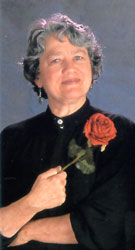



|

|
Judith Wachs of Voice of the Turtle
talks with Aaron Howard about 'creative conjecture' and the re-creation of Sephardic music in modern America.
|
|
Back in 1978, musicians Judith Wachs, Derek Burrows, Lisle Kulbach and Jay Rosenberg were performing Medieval and Renaissance music in a group called The Quadrivium. With one song, they discovered the music of Spanish Jewry. (1)
"We were among the [few] groups back then doing Sephardic music and we're the same four people all these years later," says Wachs. Based in Boston, Voice of the Turtle is one of the best-known groups performing Sephardic music in America. Theirs is an unusual marriage of artists who see the power of music more than just a presentation to a concert audience. "We are all galvanized by the idea that it is critically important to preserve oral traditions in any culture. It's not so much about preserving Sephardic music but encouraging people to look at their own culture. Take from the people around you the treasures that are often missed. Learn to value the treasures that the elders have brought with them," says Wachs. "Despite the fact I had grown up with an extensive Jewish education, I was familiar with Ashkenaz music," recalls Wachs. "But I wasn't aware of Sephardic music. I had no idea of where our search would take us." Wachs began her research at the extensive Harvard Music Library. There she found a single book containing about 20 songs with no annotations. Since they had never heard a Sephardic person sing this music, the group interpreted the songs based on the notations in the book. In other words, they didn't know if their interpretation was the true sound of the music.
"The word authentic is a problem," answers Wachs. "If I ask someone from Sarajevo who has sung a song one way for 500 years and a person who knows the same song but comes from Istanbul and sings it a different way, sometimes the melody and words will be similar, sometimes not. The very fact of the dispersion means the experience of each of the Sephardic communities is different after 1492. "Certain things are readily identifiable, certain scales that you can identify as a Sephardic song. But there are similar scales in Arabic and other music. So you can debate authenticity. There's never a time we do a concert that somebody doesn't say 'that's not the way it's sung' and someone else says 'how did you know how to sing it that way'?" "Remember, this is music and it is transmitted through oral tradition. Only since the 20th century did people write things down." Music becomes modified by whoever sings it. The Sephardic folk audience is often conservative; they expect a song to sound similar to the way their family or neighbors performed it. But a commercial audience often expects change. When a modern artist performs a folk song, it becomes modified. Voice Of the Turtle interprets Sephardic music. It's an approach Wachs calls "creative conjecture." Their performances are based on serious and continued research into the Sephardic traditions. That research includes listening to traditional Sephardic singers, people one generation removed from Morocco, Turkey and the Balkans. Twice a year, Wachs journeys to the Jewish Music Research Center in Jerusalem to listen to material collected from Sephardic communities now living in Israel. There are major efforts to document all the communities that come to Israel and anyone who knows any of the customs is recorded. Scholars seem aware of the fragility of the cultures that come to Israel. Music of the Sephardic Jews has become a creative field for research thanks to scholars like Edwin Seroussi and Isaac Levy. The efforts by Wachs to work with scholars and documentary sources has played an important role in developing a Sephardic repertoire across various traditions. Wachs has, for example, studied Sephardic para-liturgical music, the repertoire transmitted and sung by women. These are songs based on holidays, Midrash songs (songs of folklore or legend), fairy tales, customs and children's songs. "The women had some function that was performed every day of the week," explains Wachs. "If they did the wash on a Monday, that day would be filled with songs about water. They weren't necessarily 'Oh poor me, I'm washing' songs. They might be old romances or songs of the sea. "There were groups of songs that had to do with water and immersion. I learned that some of these songs were sung to accompany the bride to the mikvah prior to a wedding. This is information we gathered because we were doing the music." Up to now, Voice Of the Turtle has focussed on Sephardic music from Turkey, Morocco, Bulgaria, the former Yugoslavia, Greece, Rhodes and Jerusalem. Their 12th CD, The Sword of the Dove, is a mixture of all these styles. After all, considering that Sephardic Jews sojourned in dozens of countries in Europe, Asia and North Africa, the Turtles should have little trouble finding material for dozens of future albums.
Comment on this music or the web site. |
|||||
© 2000 RootsWorld. No reproduction of any part of this page or its associated files is permitted without express written permission.